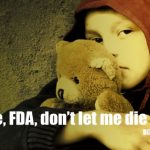
The DMD community meets the FDA at the AdCom conference. Testimonial, part 2.
Indeed, it was tough for me to attend the AdCom Conference. Throughout the day, monuments of data were built and destroyed, all expertly worded and cleverly illustrated with all kinds of graphs and charts. We certainly got our fill of graphs and charts …
And when you listen for two long hours to the list of problems your child is currently facing, or that he will be facing sooner or later before dying, it’s just horrible.
It’s quite an experience to witness some 51 testimonials and see the power that emanates from these people: children standing up (no small feat when it comes DMD), children begging to be understood by a group of adults who listen while pushing pencils in front of a crowded room of people holding back their tears. People in authority who will be making decisions on their future.
Here are some of the criteria the FDA uses to measure the effectiveness of treatment:
- The 6-minute walk test;
- The time children take to get up from the ground;
- The age at which children lose the ability to walk;
- Dystrophin production rate;
Here’s what they do not take into account:
- The ability to walk (even if it is less than 6 minutes)
- The ability to get up by one’s means (regardless of time)
- Upper body mobility;
- And the autonomy that children manage to maintain daily.
Austin Leclaire, 15 years old, went up to show us a video in which, after 62 weeks of treatment, he was able to lift his arms above his head, and which shows that he has gotten stronger instead of declining. What does this mean to a person with Duchenne muscular dystrophy? “What does that mean for me?” asks Austin. “It means independence; it means that I can feed myself … ” Read more
They came and went one after the other and were unanimous, including young people who have four years of treatment behind them: they get stronger instead of declining.
It’s truly surreal to have to watch such a dehumanizing spectacle. Again, data tyranny will win over those 51 people who were living proof of the treatment’s success. A reality that is hard to fathom.
Towards the end of the meeting, I had to get out to clear my head because I couldn’t make sense out of such a decision (not final, but still). So I headed to the lobby, and I waited for it to end. What I saw got even more upset: sad and bewildered mothers and fathers discouraged to learn that the committee would not make a recommendation to the FDA for approval of a drug that is helping to save their children.
The worst was having to see young children who had shared testimonials come out of the conference in tears. Just imagine the grief and frustration experienced by these children. The adult world, the decision-makers, people who represent society had now abandoned them.
This great community, which seems animated by a supernatural force and must still plead for access to treatments and technologies that it has often helped to fund through numerous projects over the past 20 years, this community is once again facing a wall.
I think we have no choice but to move forward TOGETHER and pool our efforts to make sure that the kids get the treatment they need: let’s remember that no one is safe from RARE DISEASES…
Read more
Forbes Market – Change.org (petition) – Boston Business Journal – CBS News
Boston Globe – Austin Leclaire – PPMD – FDA AD-COMM – Health Canada PAS
The Jett Foundation – PPMD – Duchenne Alliance – New treatments for DMD a stalled process



